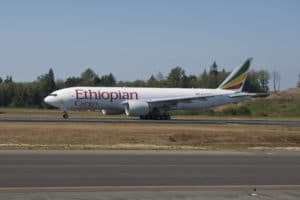Christmas is looking a little bit rosier for the air cargo industry as some indicators, including yields show an uptick, sources have told Air Cargo Week (ACW).
One of the clearest and broadest signs comes from ATC Aviation’s (chief executive officer) CEO Ingo Zimmer (pictured above). “We have increased our tonnages tremendously. In the first eight months of 2016 we achieved 143,000 tons of aircargo compared with the same period last year this reflects a 15 per cent increase.
“With the new airline contracts we gained meanwhile, and the trend with the existing airline customers we expect a 20 per cent growth in tonnages for the financial year 2016,” he tells ACW.
ATC’s new airline customers in 2016 (till now) are Air Serbia for the US, Air Asia X for India, Air Tahiti, TAP and Ethiopian Airlines for France, Silkway and CAL in Argentina and Silkway, CAL and Saudia Cargo in Brazil.
Whilst this signal of good news is supported throughout the industry it is of particular importance to ATC. “If you take into consideration that the market tonnages from our main markets are more or less flat compared with last year this means a significant growth in marketshare,” says Zimmer.
A more telling comment comes from another senior industry figure, Kales Group CEO, Peter Kales (pictured below), who went as far as to say some yields were actually on the up. “From October onwards we see increased demand for capacity and big traffics are confirmed. Overall total volumes are equal or with small increase compared to last year and on specific routes yields are even showing an upwards trend,” Kales tells ACW.
Two caveats though before the Christmas champagne is opened earlier, maybe too much earlier, than it should be. Kales is based mainly in Europe and all its input is based on export cargo out of Europe to global destinations. Others in the industry agree with this but less clearly and adding some caveats.
“ATC Aviation Services is also effected by the worldwide drop of the aircargo yields driven by the over capacities,” was ATC’s view as expressed by Zimmer. However he went on to note a general improvement in the market is helping yields.
“We can feel already that towards the end of the year the demand for space is getting much stronger and also the yields recover at least a bit,” he tells ACW.
The view from Asia is a tad more qualified. “The air cargo market in Asia remains dynamic. Passenger demand remains healthy and consequently we continue to see cargo capacity being added faster than air cargo demand growth,” Air Logistics Group managing director Asia Pacific, Vikram Singh tells ACW.
“Intra-Asia, other than feeder volumes, seems weaker against capacity than before” he adds.
One of the encouraging signs though is established markets remain firm whilst newer segments such as e-commerce acting as a driver.
“We see a considerable increase in demand for E-commerce shipments – mainly from for Asia. Overall traditional commodities remained more or less stable, such as electronics, pharma. machinery, flower, plants, bulbs, vegetables, etc, etc,” Kales adds.
In this general view they are supported by other players in other markets. “Most commodity groups remain stable however we are seeing b2c driven cargo (postal volumes, express and e-commerce) continuing to outpace other commodity groups. Other special cargo also continues to outpace general cargo,” says Singh.
Zimmer acknowledges as well that ATC has concentrated on what he called the “vertical sales” of things such as pharma, valuable cargo and courier business.
Growth spots continue to be China & India with the weakening areas being Latin America & Africa, adds Kales Group vice president, Dirk Hazenoot. Total exports from Europe – worldwide during first nine months of 2016 – have been almost flat compared to same period 2015 Hazenoot says. But “Asia (mainly China) remains very strong and we have seen growth of more than five per cent,” he adds.
Others in the market don’t dispute that growth is there but do have a different take. “We’re seeing some buoyancy in China in recent months but it does not appear sustainable,” says Singh.
That’s the good sign. Less encouraging is that North America is struggling with market demand having dropped three per cent although that’s small compared with the Africa market which dropped 15 per cent, Hazenoot adds.

He especially mentioned South Africa as a country struggling economically but went on to say many other countries in Africa are suffering from economic and political turbulence. The examples he gave are Ethiopia, Kenya, Nigeria, Sudan. “We expect some recovery towards beginning of 2017,” he adds.
Kales as it prepares for its own little year-end rally it is cautious, as indeed most of the industry is on next year. “Markets will continue to grow, airlines expand with new (mainly passenger) aircraft deliveries, and prices remain under pressure as capacity exceeds demand on many routes,” says Kales adding the interesting codicil “However additional capacities is also needed as USA and Far East are strong buyer markets with money to spend.”
“Depending on economic recovery we can expect increase in demand for example to Brazil, South Africa,” adds Kales.
A similar view of the problems the industry will continue to face in 2017 was noted by ATC who do not expect a big change. Its response though is different, much less specific, to tackle them and so tap the business it believes is out there. “We have taken measurement to make our organisation lean and to focus on our core business the sales and marketing,” says Zimmer. “Airlines will be much more under pressure to keep their cargo business profitable and this is a chance for Cargo GSSA`s in 2017 as well.”
The Asian view as outlined by Singh is like this too but it also allows for, and offers, an explanation as to why optimism endures. “Even with stellar growth next year a capacity crunch is not visible. We expect to face continued pressure on yields,” he said. But that extra capacity is proving useful in generating new markets – which Air Logistics Group is exploiting.
“Abundant Intra-Asia capacity is proving a good opportunity for feeder volumes via weaker gateways. We are careful to focus on our core airline partnerships and using these opportunities to add maximum value. We have developed smaller markets to enhance coverage and geographical leverage and again focus on adding maximum value to our core airline partnerships,” he says.






